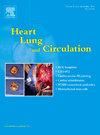肥胖患者保留射血分数的心力衰竭:一个日益增长的心脏代谢问题。
IF 2.2
4区 医学
Q2 CARDIAC & CARDIOVASCULAR SYSTEMS
引用次数: 0
摘要
心力衰竭(HF)影响了大约2.1%的澳大利亚成年人,并与大量的发病率和死亡率相关。大约一半的HF患者患有保留射血分数(HFpEF)的HF,由于人口老龄化以及肥胖和糖尿病患病率的增加,其发病率正在增加。肥胖通过多种机制驱动HFpEF,各种人体测量指标与发生HFpEF的风险之间存在线性关系。考虑到钠-葡萄糖共转运蛋白2抑制剂、矿皮质激素受体拮抗剂和胰高血糖素样肽-1激动剂等治疗方法已被证明可以改善生活质量和临床结果,因此需要提高诊断意识来识别肥胖相关的HFpEF患者。这篇综述概述了我们目前对肥胖对HFpEF发展的影响的理解,并概述了诊断方法和新的治疗选择。本文章由计算机程序翻译,如有差异,请以英文原文为准。
Heart Failure With Preserved Ejection Fraction in Patients With Obesity: A Growing Cardiometabolic Concern
Heart failure (HF) affects approximately 2.1% of adult Australians and is associated with substantial morbidity and mortality. Approximately half of all patients with HF have HF with a preserved ejection fraction (HFpEF), which is increasing in incidence driven by an ageing population and an increasing prevalence of obesity and diabetes. Obesity drives HFpEF via multiple mechanisms, with a linear relationship between various anthropometric measures and the risk of developing HFpEF. Heightened diagnostic awareness is required to identify patients with obesity-associated HFpEF, given the availability of therapeutics that have been shown to improve quality of life and clinical outcomes, including sodium-glucose cotransporter 2 inhibitors, mineralocorticoid receptor antagonists, and glucagon-like peptide-1 agonist-based therapies. This review provides an overview of our current understanding of the impact of obesity on the development of HFpEF and outlines an approach to diagnosis and new therapeutic options.
求助全文
通过发布文献求助,成功后即可免费获取论文全文。
去求助
来源期刊

Heart, Lung and Circulation
CARDIAC & CARDIOVASCULAR SYSTEMS-
CiteScore
4.50
自引率
3.80%
发文量
912
审稿时长
11.9 weeks
期刊介绍:
Heart, Lung and Circulation publishes articles integrating clinical and research activities in the fields of basic cardiovascular science, clinical cardiology and cardiac surgery, with a focus on emerging issues in cardiovascular disease. The journal promotes multidisciplinary dialogue between cardiologists, cardiothoracic surgeons, cardio-pulmonary physicians and cardiovascular scientists.
 求助内容:
求助内容: 应助结果提醒方式:
应助结果提醒方式:


